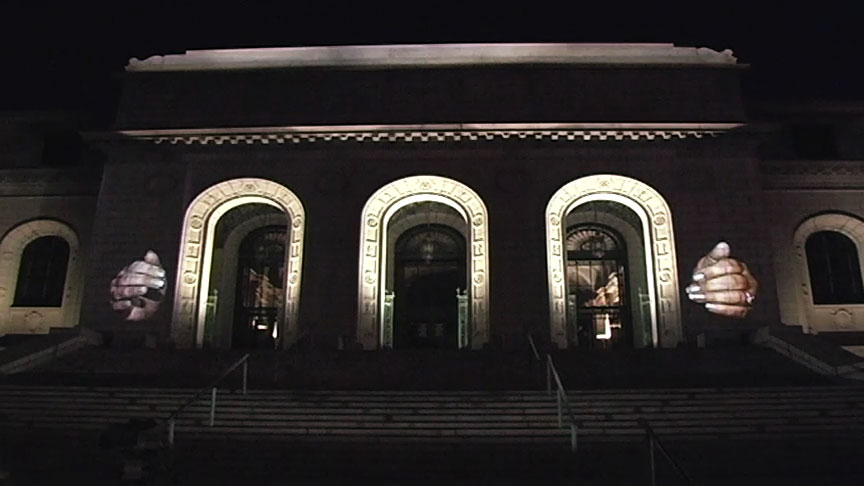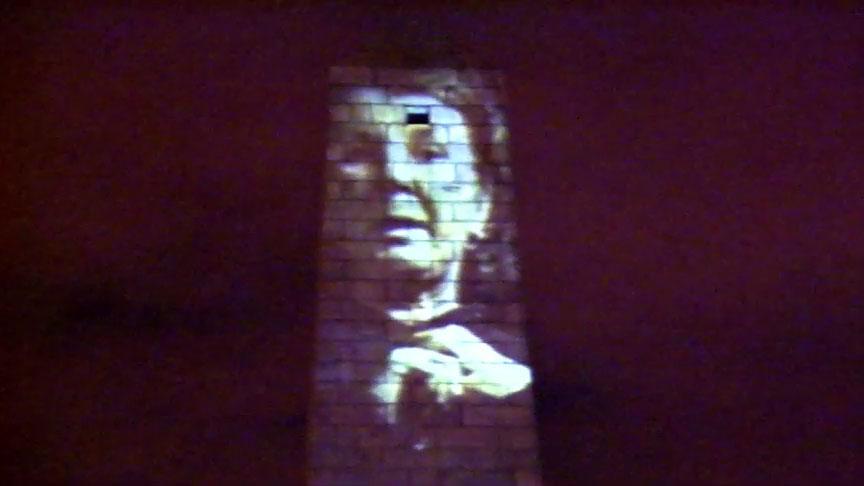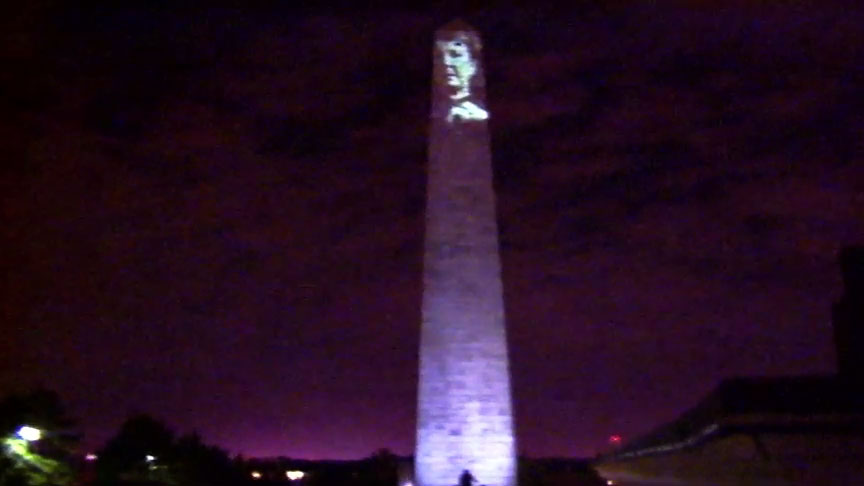Interview
Architecture and Therapy

Production still from the Art in the Twenty-First Century Season 3 episode, Power. © Art21, Inc. 2005.
Krzysztof Wodiczko discusses how he began creating video projections, and his work’s relation to architecture, spectatorship, and beauty.
ART21: How did you decide to create the video projections?
WODICZKO: When I first began this type of work in Krakow, I didn’t have any experience in filming or projecting motion images on buildings. I’d been working on still slide projections. So, the shift was radical. The projections might look similar in photographs and documents (especially photographs), but they are completely different. In the slide projections, I was animating the monuments with icons and images that I produced in order to actualize them, so they could speak on contemporary issues. Now, I create a situation for others to animate monuments and project themselves. So, the process of filming is a situation for them to learn what to say and how to say it—because I don’t tell people what they should say. I don’t know what they will say. They don’t know, themselves.
Through the experience, I am a completely different artist now; I’m not the one that I was before. My role has changed. I am proposing something that people may or may not be interested in taking advantage of. As I see now, they must reject it. They must say, “No, we’re not going to be manipulated here. We went through this before. There were so many journalists and documentary filmmakers, trying to make art of our misery, and nothing has changed. Why should we do it again?” They must put in doubt the entire operation. But then, they should learn that there is some difference between previous situations and the one I propose.
There’s more room for them, and there’s more time. It won’t be a short, one-hour filming session. They might work on this for a year to figure out what to say and therefore survive their criticism and their doubts. The project must survive. I have to show up again and again, ready to be useful. And they may realize that it’s no longer my project in which they are passive parts, but it’s becoming their project. They are becoming artists, monument animators, and truth tellers. I am becoming more of a protective person, someone who protects their process, like a mother.
There is a playful aspect to it—the animation of the monument and also the editing process, which requires reduction of the length of material and choice of what the monument should transmit. The person and the monument working together—that is an artistic process, and it must have some kind of playful and creative aspect to it. I think that, step by step, those co-artists realize that it’s their project, more and more—also that they can make good use of it for their own lives and for the lives of others. So, they’ve become co-artists, but also co-agents. They are doing something for those who, at this point, cannot do what they do: they cannot speak well, or they’re not ready, or it would be too risky for them to be part of the project. They may later be ready for it, but the project won’t be there.

Production still from the Art in the Twenty-First Century Season 3 episode, Power. © Art21, Inc. 2005.
ART21: Talk about the visual aspects of what you do.
WODICZKO: To talk about beauty is too difficult; spectacle may be more appropriate. The architecture, façades, monuments—the entire city with its various forms and arrangements is an aesthetic environment. So, entering this kind of environment, trying to speak through it, add a new dimension, project a new meaning—I have no choice but to try to be as spectacular as that environment is, or more. Even without discussing the particular aesthetic quality that I am looking for, I must match the spectacular quality of a work with the environment, in order to speak through it.
But we could also approach it from a different angle. To speak of things that are not only difficult, painful—or in many ways the opposite of spectacular or beautiful—it might be worth reaching the spectacular. To convey something difficult, it’s easier if one can have some convincing aesthetic means. We have to see the relationship between what is being said, and how it’s being transmitted. For people to open up and come closer to those who are conveying difficult truths, it may be easier through a spectacular project. So, there is a function of the spectacular, here: an artifice that is more acceptable because of its aesthetic quality.
Art, in general, seems to be a very useful artifice. Film, theater, painting, literature, media art—all of this is a very good conduit for transmitting the things that people would rather not hear or see. This is a possibility for transmitting something uncanny, something that ought to be hidden but comes to light. It takes aesthetic form as an artifice; it’s partially real and partially fictitious. So, those faces: they are partially people and partially façades, partially testimonies and partially spectacles. It’s much easier to accept them for what they’re trying to say this way than, for example, listening to someone speak directly.
It’s not attaching specific aesthetic decisions. When I am speaking through those structures, I have to learn what particular aesthetic method or technique they are using already. We’re talking about a neoclassical vocabulary of buildings: symmetry, bodily metaphor. They are wrestling with their own bodily metaphors—every building and every monument. Even architecture that seems to be far away from neoclassicism still often maintains this same bodily metaphor or play. It’s a play of corporal masses, components that form a whole. It’s an old metaphor: a social body that is made of particular bodies.

Production still from the Art in the Twenty-First Century Season 3 episode, Power. © Art21, Inc. 2005.
Most civic structures are trying to reproduce and reinforce certain concepts of unity and harmony. This kind of perfect, seamless, highly organized façade is something that fascinates people. We have a special relationship with them; they seem to be corresponding to our own desires and tendencies to become like buildings, to become as perfect as they are. We have a pleasure in looking at it because it calms us down; we are exchanging something. This is a process of architecturalization of our bodies and bodification of architecture.
Assuming that what I am saying is at least in part true, then through this kind of dialogue we are able to accept all sorts of things. For example, we are already identifying with the tower (lonely tower!) because we already also feel very lonely and lofty and dramatically alienated. We might wonder what’s happening, when there is a projection happening on that tower—because there is already us inhabiting that tower. Now, there is somebody else there. It’s difficult; it is uncanny because it’s us and also it’s somebody else. But via this architectural form, we somehow build a bridge, link with other people.
I have seen some evidence of it, in the case of earlier projections, when I was closely watching the reaction of various members of the public. It was amazing. Someone said that rhetorical question, out loud: “How is it possible that one doesn’t believe another human being but does believe the tower?” In Polish, it’s actually much more humorous, because belief and tower are the same word. But the question shows that there is a special relation that we have with the spectacle of architecture.
All of those devices that I use in projection are simply attempts to make it as organic as possible, so the boundary between architecture and projected body would be blurred. The skin of the building and the skin of the person would be background and foreground at the same time. It will be shifting focus. And I am not sure if I am always successful. Sometimes I think that, perhaps, I ask too much from those silent and motionless structures.

Production still from the Art in the Twenty-First Century Season 3 episode, Power. © Art21, Inc. 2005.
ART21: How do you view cities today?
WODICZKO: What are our cities? Are they environments that are trying to say something to us? Are they environments in which we communicate with each other? Or are they perhaps the environments of things that we don’t see—of silences, of the voices which we don’t, or would rather not, hear? The places of all of those back alleys where, perhaps, the real public space is—where the experiences of which we should be speaking, where voices that we should be listening to, are hidden in the shadows of monuments and memorials?
That’s where the city that interest me is—in all of those places where we are even afraid to go, and all of those places that we get to when we make a mistake, take a wrong bus, a wrong subway line. One of the objectives behind my projections is to bring to light all of those voices and experiences, and to animate public space with them in a kind of inspiring and provocative way—maybe in a way of protest.
I don’t know if this is political art. Or is this psychotherapeutic art? Or is this an ethical proposition? I don’t know who I am. Sometimes I’m thinking of myself as what Donald Winnicott, the psychoanalyst, called a “good-enough mother”: someone who protects the process in which others can develop and create something in an atmosphere of trust—develop the ability to cope with life—though often damaged and wounded by their experiences. Perhaps projects of the kind I’m working on help those who are ready to take advantage of them, to make that leap.
This interview was originally published on PBS.org in September 2005 and was republished on Art21.org in November 2011.



